Simple & efficient entry control solution: Tripod entrance gate
The overviwe of tripod entrance gate
It relates to a tripod entrance gate for controlling the passage of people with a locking unit which can be rotated about an axis of rotation which is inclined downwards by approximately 45° relative to the horizontal and which can be locked against rotation by means of an unlockable locking mechanism and which can be released for rotation in at least one direction of rotation and which has at least two locking arms which are inclined to the axis of rotation, of which in the operating position of the system one is in a substantially horizontal position blocking the passage and the other locking arms or arms are moved out of the passage area, the locking arms being turned out one after the other by turning the locking unit as a result of a command to the unlockable locking mechanism the position blocking the passage into a position releasing the passage and are articulated to a bearing plate of the blocking unit in such a way that the blocking arm, which is in its blocking position in the operating state of the system, responds when the system is put out of operation, for example as a result of a power failure or a power shutdown an unlocking mechanism can be pivoted from its locked normal position on the bearing plate into a release position that allows unhindered passage of people and this automatically returns to its locked normal position after the process that triggers the unlocking has ceased.
Such tripod gate barriers are used at pedestrian gates to enable controlled entry and exit of people. Depending on previously defined criteria, the passage is released for one person at a time by turning the locking device by one step, with the next blocking element behind each person passing through being brought into its position that initially blocks the passage for a subsequent person. In such systems, however, it must also be ensured that if a fault occurs, e.g. due to a power failure, or if the tripod barrier is deliberately deactivated or in a dangerous situation, unhindered passage is possible for as many people as possible, thus keeping an escape route open.
The known one- or two-arm barriers have proven to be disadvantageous in that they develop a high impact force and thus the risk of injuries, especially for children, due to the comparatively fast rotation that they have to carry out. The three-arm barriers have therefore mainly become established.
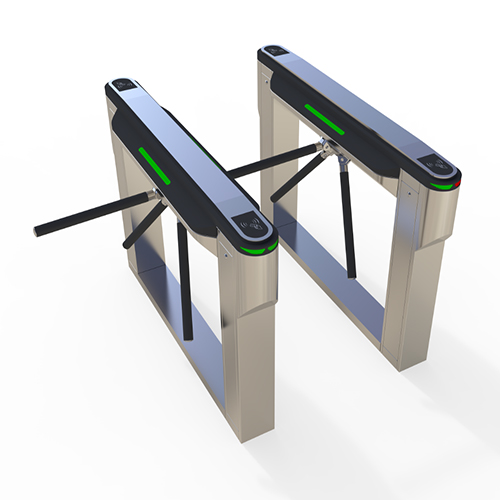
An automatic tripod gate system is known which has three locking arms which extend trigonally from a bearing plate and which, by rotating the turnstile, successively move into a position blocking the passage and releasing the passage. In their normal position, the locking arms protrude from the bearing plate at a certain angle, but are connected to it in an articulated manner in such a way that the locking arm, which is in its locked position, e.g In the event of a power failure or when the power is switched off, its joint is unlocked and can be pivoted by the action of gravity into a release position that allows unhindered passage. In this system, the locking arm that is unlocked in this way, i.e. deactivated, must be brought into its normal operating position by hand in order to resume operation. This is very complicated and time-consuming and has a particularly disadvantageous effect on larger areas that need to be monitored.
A similar tripod turnstile access control system in which, after a locking arm is folded away from its locking position due to, for example, an accident or an intended decommissioning for the resumption of normal operation, this locking arm is also manually brought back into its operating position must.
A similar access entrance gate system in which an unlocked, i.e. deactivated, locking arm after resumption of operation by turning the turnstile or the bearing plate carrying the locking arms, by at least one step due to the effect of gravity, it automatically returns to its normal operating position, in which it is held by locking means. In order for the locking arm in question to return to its normal operating position in this way, it must reach a certain position when the turnstile on the bearing plate is rotated. Gravity can only develop its full effect when it reaches or passes the lower apex of the rotation. Therefore, the automatic return of an unlocked locking arm is not really guaranteed when the turnstile advances in just one step. There is also an explicit reference in the documents mentioned that the locking arm reaches its operating position in a particularly safe manner when the turnstile is advanced by at least two steps, i.e. when the locking arm passes through the lower apex of the rotation. This return of the unlocked locking arm with one or two steps involves a certain risk of injury due to the rapid movement when the locking arm re-engages.
The locking of the locking elements of known locking positions is effected via lever systems and clamping bodies, via hydraulic or pneumatic brakes, which is very complex, cost-intensive and also prone to failure. A roller system running on a cam is required to precisely position the locking elements in the locking positions. Hydraulic and pneumatic systems are also subject to high safety requirements. Clamping bodies, cam disks and pivot bolts as locking elements cannot be unlocked under load.
Another disadvantage of these well-known turnstile systems is that they are driven by a geared motor, which, depending on the type of gear, produces unpleasant noises and is subject to high levels of wear. A relatively high amount of force is required to continue turning the locking unit. A self-locking gear can no longer be turned in the event of a power failure from the outside, which can have a very disadvantageous effect in the event of a panic, and self-locking gears also require a high external actuation force in the event of a power failure in order to be moved.
The object is to make the automatic return of a locking element pivoted from its normal position to its release position safe and reliable in a turnstile of the type mentioned at the beginning and thus also to ensure that the drop arm tripod turnstile can be put back into operation as quickly as possible after an accident of any kind has been eliminated reliable and uncomplicated way. The device should be as simple as possible in its structure, functionally reliable and low-wear.
This is achieved in that the locking of each locking arm on the bearing plate is produced by a locking element reaching through an opening, that in the event of a power interruption, the locking element of the locking arm in the locking position can be released mechanically against a spring force from the engagement at the opening and when released Locking, a force acting eccentrically on this locking arm pivots it in its bearing on the bearing plate about an axis of rotation parallel to the main axis of rotation of the locking unit from its normal position into its release position and that when the power supply returns, the pivoted locking arm can be temporarily locked and by rotating the bearing plate by less As an advance step of the rfid tripod turnstile, this locking arm can be returned to its normal position by its forced relative rotation to the bearing plate and can be locked again in this position by the locking element.
To reset the swung-out locking arm, all you need to do is turn the locking unit by about half an increment of the tripod turnstile security gate. This takes place in a very safe and reliable and also gentle manner without a hard impact when it engages and without risk of injury to people.
The force acting eccentrically on the locking arm can be a spring force and/or gravity.
The locking arms can be pivotally held in openings in the bearing plate via receiving pins and can be locked relative to the bearing plate by a locking element.
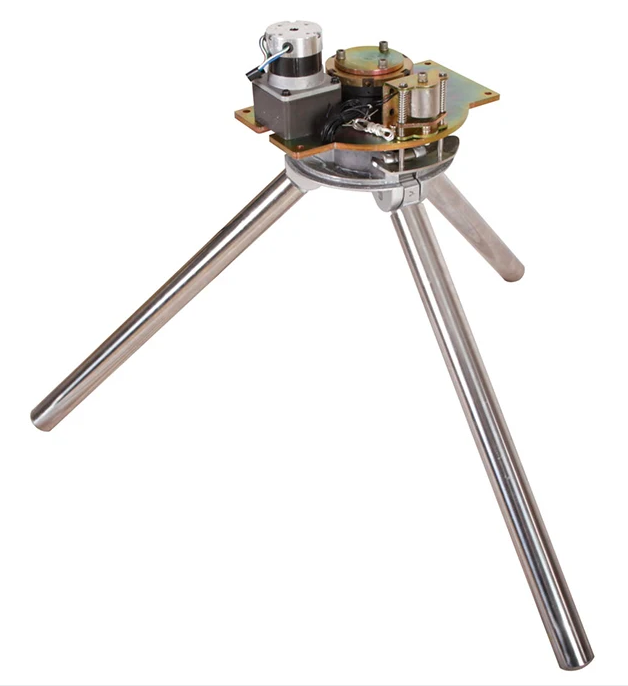
The spring that acts eccentrically on the receiving pin or the locking arm is preferably a helical spring. In contrast to a spiral spring, it is less easily destroyed by the rotating movements.
The locking element can be a locking pin which protrudes through an opening in the bearing plate and is moved out of engagement in the opening against a spring force by an unlocking lever which can be pivoted in the event of a power failure.
An opening is preferably provided on the bearing plate in the area of each turnstile bar for the passage of a locking pin, which can be radially displaceable and released from engagement in the opening by an unlocking lever that can be pivoted in the event of a power failure against a spring force on the locking arm or on a receiving pin of the locking arm is. Such a metal turnstile is very simple in construction but reliable in its operation.
During normal operation of the tripod entrance turnstile, the unlocking lever can be held securely at a distance from the locking pin by a first electric lifting magnet against the force of an unlocking spring.
The turnstile bars are pivotally held in openings in the bearing plate either directly or preferably via mounting pins; On the back of the locking arms or the receiving pins, engagement means are provided, on which a spring force can act eccentrically, the other end of which is anchored on the back of the bearing plate; The unlocked locking arm can be pivoted about an axis parallel to the main axis of rotation of the locking unit by the spring force, for example of a tension spring or coil spring, in the opening of the bearing plate.
According to a preferred embodimen, several projecting pins can be arranged as engagement means on the back of the locking arms or their receiving pins; A tension spring, preferably a coil spring, can act eccentrically on one of these pins, the other end of which is anchored on the back of the bearing plate.
According to another embodiment, a friction wheel can be arranged as an engagement means on the back of the locking arms or their receiving pins.
According to a further embodiment, a toothed disk can be arranged as an engagement means on the back of the locking arms or their receiving pins.
When the turnstile access control system is put back into operation, a blocking lever is temporarily brought into a positive or non-positive connection with the blocking arm swung out of the passage area in order to lock this blocking arm; By rotating the locking unit or the bearing plate by less than one step of the locking unit, a relative rotation of the locking arm to the bearing plate is forced and the locking arm is returned to its normal position and locked again.
The blocking lever preferably has locking notches with which it can come into positive connection on pins projecting from the back of the locking arm or its receiving pin or with a toothed disk arranged on the back of the locking arm or its receiving pin.
The locking notches advantageously have a rather flat flank for the insertion of a pin or a tooth and a steep flank against which a pin or a tooth comes into contact when it engages. Due to the force component acting primarily in the direction of engagement on the steep flank, the pin or the toothing can be held in its engagement with a relatively low leverage force.
When the power supply is reinserted, the blocking lever can advantageously be actuated by a second electric lifting magnet to lock the blocking arm that has been pivoted out of the passage area.
A brushless direct current motor without gearbox with direct drive is preferred as the drive motor for the locking unit. It is subject to less wear and tear than a geared motor.
In addition, the locking unit can be secured against unauthorized rotation by an electromagnetic brake that acts directly on the drive shaft of the locking unit. It provides overload protection and also offers protection against damage, for example due to vandalism.
The position control, position regulation and position query for the locking unit can be carried out via a rotary encoder installed directly on the rotor shaft of the drive motor. This encoder can be a resolver.
The detailed description
It is described in more detail below using the attached drawing as an example; show it
Fig.1 is a perspective view of a tripod entrance turnstile
Fig.2 is a perspective front view of the locking unit used in the entrance tripod turnstile according to FIG.1
Fig.3 is a perspective rear view of the locking unit in the operating state according to Fig.2
Fig.4 shows the view of the locking unit according to FIG. 2 when a locking element is unlocked
Fig.5 shows the rear view of the locking unit when a locking element is unlocked
Fig.6 and Fig.7 show the rear view of the locking unit when a locking element is pivoted into its release position
Fig.8 and Fig.9 show the rear view of the locking unit when the previously pivoted locking element returns to its normal operating position.
Fig.1 shows a three-arm turnstile with a locking unit 1 which can be rotated about an axis of rotation inclined by approximately 45° to the horizontal, from which three locking elements 2, here in the form of locking arms 2, extend to one another at an angle of 120° each. The locking unit 1 is mounted on a carrier plate 3 according to FIG. The locking arms 2 extend at the same angle from a bearing plate 4, at one end of which they are held in receiving pins 5, which are pivotably mounted in openings in the bearing plate 4. A collar 6 can be formed on the circumference of the bearing plate 4, via which the bearing plate 4 is rotatably mounted in a circular opening in the carrier plate 3. On each receiving pin 5 there is a locking pin 7 which is acted upon radially outwards by a spring but can be moved radially against the force of the spring (see below and FIG.5), which in the normal position passes through a corresponding opening 8, preferably a bore the bearing plate 4 protrudes. In this normal position of the locking pin 7 shown in FIG.2, it holds the associated locking arm 2 via its receiving pin 5 in its normal angular position, which is also the normal operating position of the turnstile. The locking pin 7, which is located at the topmost vertex of the rotatable bearing plate 4, can be actuated against the spring force acting on it by an unlocking lever 9, which is in the normal position, i.e. at a distance from the locking pin, by a first electric lifting magnet 10 against the force of an unlocking spring 11 7, is held.
According to Fig.3, 5 pins 12 protrude from the back of the receiving pins as engagement means. A tension spring 13, which is preferably a coil spring and is anchored to the bearing plate 4 with its other end, engages on one of the pins 12 of each receiving pin 5. On the back of the carrier plate 3, a blocking lever 14 is also pivotably arranged, which can come into engagement with individual of the pins 12 of the receiving pin 5 located in the top position with locking notches 15 formed on its one, longer lever arm, but through in the normal operating state of the turnstile a spring 16 is held out of engagement. The other, shorter arm of the blocking lever 1 4 is in operative connection with a second electric lifting magnet 1 7, which is normally de-energized. The locking notches 1 5 advantageously have a rather flat and a steep flank. The flat flank allows a pin 1 2 to slide in without any problems, which then comes into contact with the steep flank and can therefore be held in engagement with a relatively low lever force due to the larger force component resulting in the direction of engagement.
Instead of the pins 12, a friction wheel or a toothed disk can be provided as an engagement means on the back of the receiving pin 5 (or the locking arms 2 directly).
During normal operation of the half height tripod turnstile, one of the three locking arms 2 projects horizontally into a pedestrian passage, while the other two locking arms 2 are pivoted out of the passage into positions pointing obliquely downwards, as shown in Fig.1. If a person enters the tripod turnstile door and wants to pass, the locking arm 2, which is horizontal, i.e. in the locked position, is moved out of its locked position after an actuation signal is triggered by the bearing plate 4 being moved by a drive motor (not shown) by one step, i.e. by approximately 120 °, is rotated. The passage for this one person is released, while at the same time the blocking arm 2 following in the direction of rotation comes into its horizontal, i.e. blocking position, the passage for a following person is initially blocked again and can only be released again after a further actuation signal. The locking unit or the bearing plate 4 is secured against unauthorized rotation by an electromagnetic brake. This preferably acts directly on the output shaft of the drive motor or the drive shaft of the bearing plate 4. Because of the lower torque, this achieves effective overload protection and also protection against damage caused by vandalism, for example. The drive motor is preferably a brushless DC motor without a gear, i.e. with direct drive and high output torque.
In the event of a malfunction, e.g. a power failure or a deliberate shutdown, it must be ensured that the locking arm 2, which is currently in the locking position, is moved out of its horizontal, locking position, i.e. out of the passage area, and that unhindered passage is possible for all people. e.g. also as an escape route.
In the event of a power interruption, in the electromechanical tripod turnstile described here, the first electric lifting magnet 10 is de-energized, so it releases the unlocking lever 9, whereupon it is pivoted about its axis of rotation 18 by the force of the unlocking spring 11 and the locking pin 7 of the locking pin 7 is in the locked position Locking arm 2 (see Fig. 4) is actuated in such a way that it is moved radially inwards and out of its engagement in the opening 8 of the bearing plate 4 against the force of a spring acting on it and the locking of the relevant receiving pin 5 and thus the Locking arm 2 is released. Due to the tension spring 1 3, which preferably acts eccentrically on one of its pins 1 2, this receiving pin 5, together with the associated locking arm 2, which is initially still in the locking position, is pivoted about an axis parallel to the main axis of rotation of the locking unit 1 and is thereby automatically moved out of the passage area (see Fig. 5 and 6) so that the turnstile can be passed unhindered. The locking arm 2 falls with its receiving pin 5 due to gravity into a vertically downward position (see Fig. 7), with the pin 12 of the receiving pin 5, on which the tension spring 13 engages, reaches beyond the lower apex during rotation, the tension spring 13 is tensioned again. The tension spring 13 is preferably a coil spring 13; In contrast to, for example, a spiral spring, it is not destroyed by the rotations and advantageously also develops a certain braking effect or damping effect when the apex is exceeded.
When voltage returns or in response to a control command, the unlocking lever 9 is pivoted back into its normal operating position by the electric lifting magnet 10. The second electric lifting magnet 17 is now also supplied with electricity, it attracts the lever arm of the blocking lever 14 that is operatively connected to it and pivots the blocking lever 14 about its axis 19 until it comes into engagement with at least one of its locking notches 15 one of the pins 12 on the back of the receiving pin 5 or with the receiving pin 5 or the locking arm 2 otherwise creates a positive or non-positive connection (see Fig.8). The entire locking unit 1 is now driven by the drive motor, not shown If the rotation lock is rotated by about half an indexing step, the swung-out locking arm 2, which is held by the locking lever 14, rotates forcibly relative to the locking unit 1 or to the bearing plate 4 until it reaches its operating position and its locking pin 7 is brought back into engagement by spring force the bearing plate 4 engages and the locking arm 2 in this Position locked again (see Fig.9). After the locking arm 2 has been locked, the second electric lifting magnet 17 is de-energized,? and the spring 16 acting on the blocking lever 14 moves it back to its starting position. This can be supported by resetting the rotation lock by half an index step so that the pin 1 2 locked in a notch 1 5 moves away from its steep flank (see above) solves.
Since the locking unit 1 only has to be rotated by half an index step in order to return the swung-out locking arm 2 to its operating position, as described, this is done in a particularly safe and reliable manner and without Risk of injury to people. List of reference symbols:
1. Locking unit
2. Locking arms
3. Carrier plate
4. Bearing plate
5. Mounting pins
6. Frets
7. locking pins, locking element
8. Opening
9. Release lever
10. First electric lifting magnet
11. Release spring
12. Pins
13. Tension spring, coil spring
14. Blocking lever
15. Notches
16. Spring
17. Second electric lifting magnet
18. Axis of rotation
19. Axis
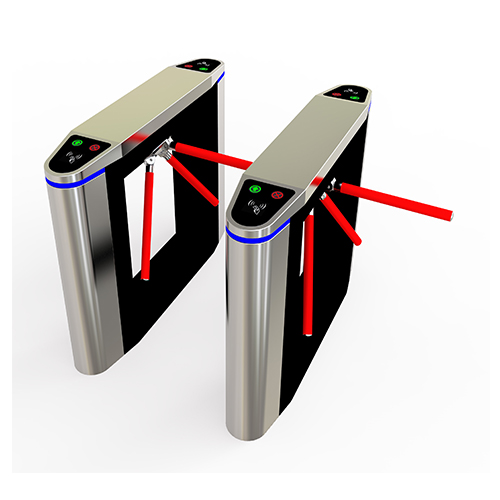
Claims
1. A tripod entrance gate for controlling the passage of persons having a blocking unit (1) which can be rotated about a rotational axis which is inclined downward by approximately 45° with respect to the horizontal, can be locked against rotation by means of an unlockable locking mechanism, can be released for rotation in at least one rotational direction, and has at least two blocking arms (2) which are inclined with respect to the rotational axis and of which, in the operational position of the system, in each case one unblocking arm (2) is situated in a substantially horizontal blocking position which locks the passage and the other blocking arm (2) or blocking arms (2) is/are moved out of the passage region, it being possible for the blocking arms (2) to be moved one after another from the position which locks the passage into a position which releases the passage as a result of rotation of the blocking unit (1 ) which is made possible as a consequence of a command to the unlockable locking mechanism, and said blocking arms (2) being articulated on a bearing plate (4) of the blocking unit (1 ) in such a way that the blocking arm (2) which is situated in its blocking position in the operational state of the system can be pivoted, by triggering of an unlocking mechanism, out of its locked normal position on the bearing plate (4) into its release position which permits the unimpeded passage of persons in the case of the system being rendered nonoperational, for example as a consequence of a power cut or of the power being switched off, and in such a way that said blocking arm (2) can be moved back automatically into its locked normal position after termination of the operation which triggers the unlocking action, wherein the locking of each blocking arm (2) on the bearing plate (4) is produced by a locking element (7) which acts through an opening (8), wherein, if the power is interrupted, the locking element (7) of the blocking arm (2) which is situated in the blocking position can be released mechanically from the engagement on the opening (8) counter to a spring force, wherein, when the locking action is released, a force (13) which acts eccentrically on this blocking arm (2) pivots the latter in its mounting on the bearing plate (4), about a rotational axis which is parallel to the main rotational axis of the blocking unit (1), rotationally out of its normal position into its release position, and wherein, when the power supply is restored, the pivoted blocking arm (2) can be arrested temporarily and, by rotation of the locking plate (4) by less than one advance switching step of the rotary lock, this blocking arm (2) can be moved back into its normal position as a result of its relative rotation to the bearing plate (4) which is brought about in the process, and can be locked in said normal position again by the locking element (7).
2. The tripod waist high turnstileas in claim 1 , wherein the force which acts eccentrically on the blocking arm (2) is a spring force (13).
3. The electronics tripod turnstile in claim 1 , wherein theforce which acts eccentrically on the blocking arm (2) is gravity.
4. The entrance tripod gate in claim 1 , wherein theblocking arms (2) are held pivotably in openings of the bearing plate (4) via receiving journals (5) and are locked with respect to the bearing plate (4) by a locking element (7).
5. The tripod turnstile gate system in claim 1, wherein thelocking element is a locking journal (7) which protrudes through an opening (8) of the bearing plate(4) and can be moved out of engagement in the opening (8) counter to a spring force by an unlocking lever (9) which can be pivoted in the case of a power cut.
6. The tripod turnstile gate in claim 1 , wherein anopening (8) is provided for the engagement of a locking journal (7) on the bearing plate (4) in the regionof each blocking arm (2), which locking journal (7) can be displaced radially on the blocking arm (2) or on a receiving journal (5) of the blocking arm (2) counter to a spring force by an unlocking lever (9), which can be pivoted in the event of a power cut, and can be released from the engagement in the opening (8).
7. The tripod turnstile security gate as claimed in claim 5 or 6, wherein,during normal operation of the rotary lock, the unlocking lever (9) is held at a spacing from the lockingjournal (7), counter to the force of an unlocking spring (11), by a first electric lifting magnet (10).
8. The tripod entrance gateas claimed in claim 1, wherein theblocking arms (2) are held pivotably in openings of the bearing plate (4) directly or via receiving journals (5), and engagement means are provided on the rear side of the blocking arms (2) or of the receiving journals (5), on which engagement means a spring force (13) acts eccentrically, and the other end of which engagement means is anchored on the rear side of the bearing plate (4), and wherein the unlocked blocking arm (2) can be pivoted by this spring force (13) in the opening of the bearing plate (4) about an axis which is parallel to the main rotational axis of the blocking unit (1).
9. The tripod barrier bidirectional turnstile as claimed in claim 8, wherein a plurality of protruding pins (12) are arranged as engagement means on the rear side of the blocking arms(2) or of their receiving journals (5), and a tensionspring (1 3) acts eccentrically on one of said pins (1 2), the other end of which tension spring (1 3) is anchored on the rear side of the bearing plate (4).
10. The tripod turnstile boom barrier as claimed in claim 8, wherein a friction wheel is arranged as engagement means on therear side of the blocking arms (2) or of their receivingjournals (5).
11. The tripod access control gate as claimed in claim 8, wherein atoothed disk is arranged as engagement means onthe rear side of the blocking arms (2) or of their receiving journals (5).
12. The tripod security gate as claimed in claim 1 , wherein, whenthe system is set in operation again, a locking lever(14) can be connected temporarily to the blocking arm (2) which is pivoted out of the passage region, by a positive or nonpositive connection, for the purpose of arresting this blocking arm (2), and said blocking arm (2) can be returned into its normal position and can be locked again as a result of a rotation of the blocking arm (2) relative to the bearing plate (4) which is brought about by rotation of the bearing plate (4) by less than one advance switching step of the blocking unit (1).
13. The tripod barrier construction turnstile gate in claim 12, wherein thelocking lever (1 4) has latching notches (15), by wayof which it can be brought into a positively locking connection on pins (1 2) which protrude from the rear side of the blocking arm (2) or its receiving journal (5).
14. The tripod barrier gate as claimed in claim 1 3 or 1 4, whereinthe latching notches (1 5) have a rather flat flank fora pin (1 2) or a toothing system to slide into and a steep flank, with which a pin (1 2) or a toothing system comes into contact during latching.
15. The entry tripod turnstile in claim 1 2, wherein, whenthe power supply is restored, the locking lever (14)can be actuated by a second electric lifting magnet (17) for arresting the blocking arm (2) which is pivoted out of the passage region.
16. The tripod entrance turnstileas claimed in one of the precedingclaims, wherein the blocking unit (1) can be driven by a drive motor which is a brushless DC motor without gear mechanism and with direct drive.
17. The tripod entrance gate turnstile as claimed in one of the precedingclaims, wherein the blocking unit (1) can be driven by a drive motor via a drive shaft and is secured against impermissible rotation by an electromagnetic brake which acts directly on said drive shaft.
18. The tripod entrance turnstile gate as claimed in claim 1 7, wherein arotary encoder for positional control, for positional regulation and positional sensing is installed in the drive motor directly on its rotor shaft.
19. The tripod entrance turnstile gate turnstile claimed in claim 19, wherein the rotary encoder is a resolver.









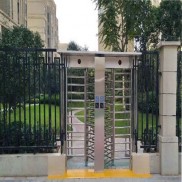 Double Lane Full Height Turnstile Gate for Residential Area
Double Lane Full Height Turnstile Gate for Residential Area
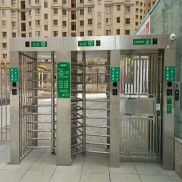 Dual Lane Tandem Full Height Turnstile Gate for Industry Park
Dual Lane Tandem Full Height Turnstile Gate for Industry Park
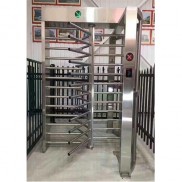 Single Full Height Security Turnstile for Office Buildings
Single Full Height Security Turnstile for Office Buildings
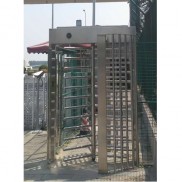 Motorised Double Full-Height Turnstile for Office Buildings
Motorised Double Full-Height Turnstile for Office Buildings







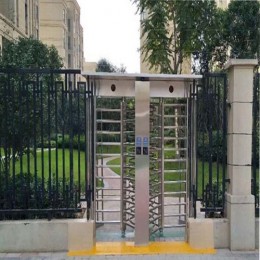
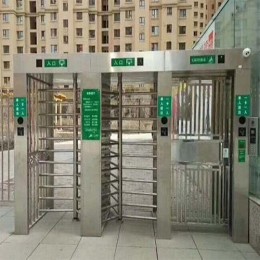













Please leave a message if you are interested in this model